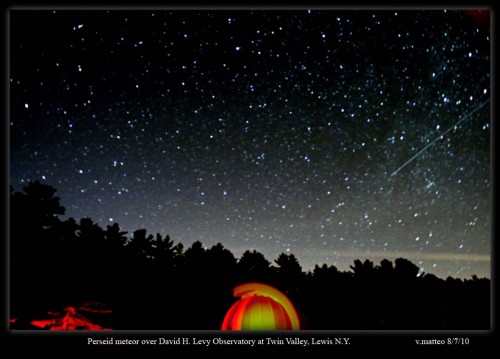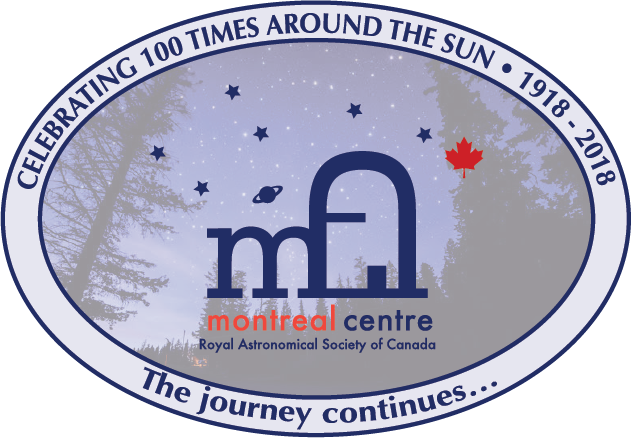By David Levy
I wish to invite the members and friends of the RASC Montreal Centre to consider coming to our ninth annual Adirondack Astronomy Retreat. It is held each year at the Twin Valleys Camp, owned by The State University of New York (SUNY) at Plattsburgh. In 2012 the first retreat will be July 15-18; the second from July 19-22. Both events are already wait-listed, but you may write the Sharing the Sky Foundation at info@sharingthesky.org for details.
In past years we have enjoyed some lovely nights, and spectacular days. In 2010, Clara Scattolin, age 12 at the time, delighted us with her “Star Trek Observing Project” for which she prepared a list of objects that were featured in at least one of the several Star Trek series.
The site is very special to me. During the summers of 1964, 1965, and 1966, I attended the Adirondack Science Camp there. In 1965 we were asked to come up with science projects that could be presented, in whole or in part, at Parents visiting weekend at the end of the season. The director, Ernie Coons, said back then that this would NOT be a traditional school science fair. “I want your projects to soar,” he suggested; “Your project should stretch you to your limits—so much so that it could actually fail.” When we heard these words we laughed, since Ernie was a teaser at the time. “I am not joking now,” he insisted. “Do you think this is a joke? It is not.” Ernie framed his words deliberately, because he felt that failure was the great teacher. If you never fail, he believed, then you were not trying hard enough.
I came up with something, an observing plan based on what Miss Williamson was encouraging us to do in Montreal. It turned out that my observing logs, now posted on the national RASC website, were a part of that. But I left camp that year with what I thought was an unsatisfactory project. Two months later, while walking to a French Oral examination at Westmount High, I thought of the newly discovered comet Ikeya-Seki. The thought hit me with full force. I was going to begin a search for comets! “Je veux decouvrir une comete!” I announced at the French Oral. My French teacher was flabbergasted. “How the heck to you expect top make any money doing that?” Mr. Hutchison asked. He then warned me to keep at it, adding that if I didn’t find a comet within 20 years, he’d come back and lower my mark!” I began my project, called CN3, on December 17, 1965, and discovered my first comet 19 years later.
In 1967 I was almost expelled from the Centre and the Society. I was accused of breaking the antique barograph and then being impolite to Miss Williamson. “Whatever you do,” one new member was advised back in 1968, “avoid Levy, our persona non grata. He will never amount to anything.”
I am glad I never abandoned the Montreal Centre and the RASC, which I love and cherish deeply. Miss Williamson and I even became good friends later in her life. More than four decades later, my wife Wendee and I hold an increasingly popular Adirondack Astronomy Retreat at Twin Valleys Camp. The year 2011 was one of our best seasons ever. Our week was a symphony of sparkling nights. When we arrived late in July, the forecast was not favorable, with some rain forecast for almost every day. However, the rain generally was light and the sky cleared off before nightfall almost every night. For the first time since our event began, we had desert-like conditions, with good viewing available on six out of seven nights. These nights reinforced my feeling that the clarity of the Adirondack sky can exceed that of the Arizona home that Wendee and I share.
The purpose of our retreat is to rediscover our astronomical roots, to remind its attendees why we became interested in astronomy in the first place. This place is a land of unsurpassed magic and peace, a site whose visitors have the opportunity to step back from life’s raging waters, and reflect calmly. Here we return to our roots.
As usual, the week is divided into two sessions of three nights each. Those who wish to attend both halves get the “interim day” as a bonus. In 2011 even that night was clear.
The “VIP Night” is an annual event we all look forward to. On this night faculty and administration members from SUNY Plattsburgh join us for dinner and observing. Most years William Ehmann, who played a crucial role eight years ago in getting this event started, comes all the way from Mercy College near New York City. Thanks partly to what goes on during these VIP nights, the AAR now has an observatory with a large Meade 14-inch reflector telescope which I used for comet hunting one night. It is similar to the one that our Sharing the Sky Foundation recently donated to the Montreal Centre.
Unlike other conventions or professional gatherings which cram many papers into brief periods of time, thanks to the AAR’s emphasis on “retreat” we are pretty light on our lecture schedule. Last year I began with a presentation on NASA’s evolution from its origins in 1958 to its finest hour only 11 years later when Armstrong and Aldrin set foot on the Moon. NASA used the time since then to build the largest building ever constructed in Earth orbit, the International Space Station. I made this talk personal by recounting the honor I felt when I had a chance to use the great Hubble telescope to observe Comet Shoemaker-Levy 9, and about the week of that comet’s impacts into Jupiter, during which I got to meet President Clinton and Vice President Gore. But as thrilling as that week was, nothing can beat the pure joy and sense of accomplishment that I feel whenever I am at the AAR.
Even though both sessions are wait-listed, we hope to see many of you at AAR in July. The people are fun and special, but the location, which boasts a sky among the darkest in eastern North America, is unsurpassed. I look forward to seeing you there.
2012 dates:
July 15-18 first retreat
July 19-22 second retreat. Both events are already wait-listed.
Please write Sharing the Sky Foundation at info@sharingthesky.org for details.


